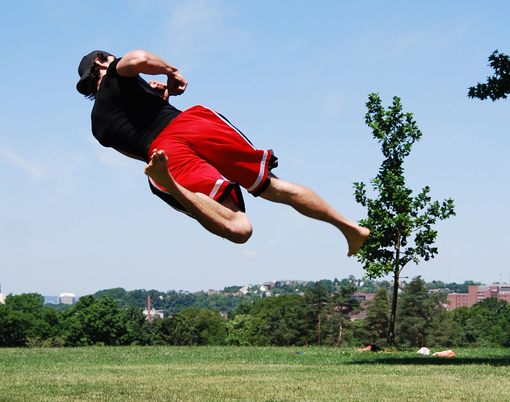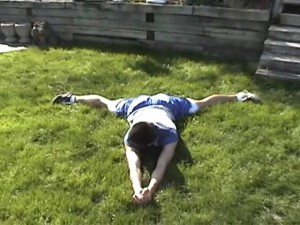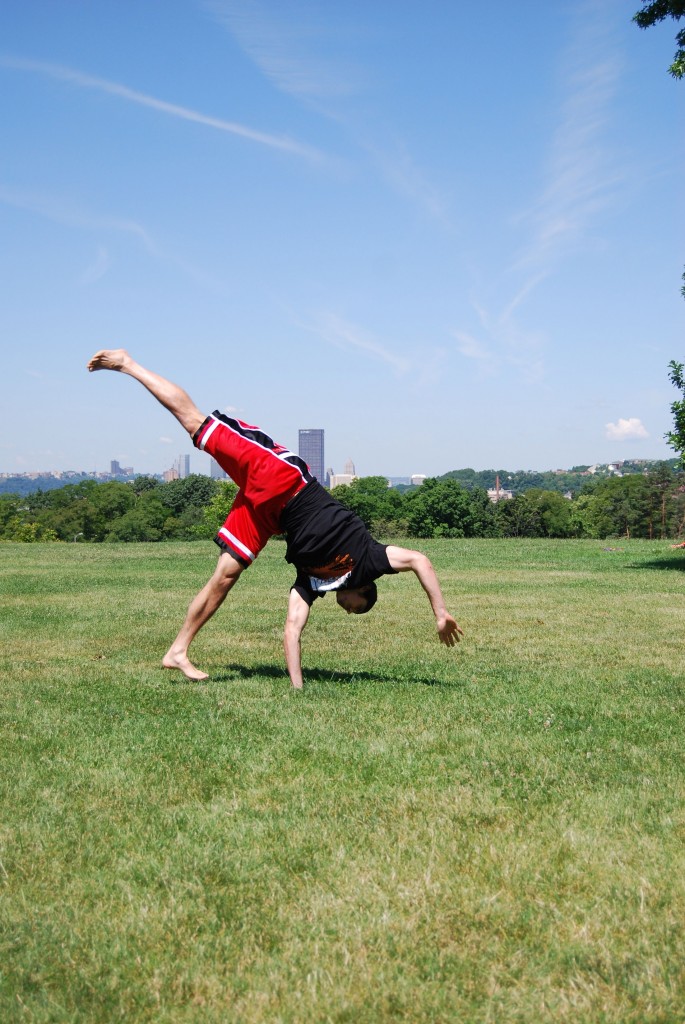It changed my life forever. I had no formal experience. No martial arts training. No gymnastics training. No training facilities. No safety training. Nothing. Just a bed of grass and an itch to do some insanely cool shit. Tricking—short for “martial arts tricking”—permeated my pores like poison. There was something about the aesthetic blend of [...]
 It changed my life forever.
It changed my life forever.
I had no formal experience. No martial arts training. No gymnastics training. No training facilities. No safety training.
Nothing.
Just a bed of grass and an itch to do some insanely cool shit.
Tricking—short for “martial arts tricking”—permeated my pores like poison. There was something about the aesthetic blend of flips, kicks, and twists that hypnotized me.
Most everyone sees tricking as this offshoot activity—something they would and could never get involved with. Maybe they think they’re not good enough. Maybe they’re afraid.
But everyone should trick. (You’ll learn a thing or two about yourself and the world, trust me.) Starting is easy; it’s not as scary or as tough as it seems. Just decide and dive.
This guide will show you how.
THE BACKYARD MINDSET – WHY TRICK?
 Tricking is more than doing insanely cool shit. Sure, doing a cartwheel without hands is awesome, but it has a host of benefits:
Tricking is more than doing insanely cool shit. Sure, doing a cartwheel without hands is awesome, but it has a host of benefits:
- It forces you to up your mobility and flexibility game.
- It teaches you movement and how to orchestrate your body in a coordinated manner.
- It replaces plyometrics. You can keep doing your depth jumps. I’ll be flipping, kicks, and twisting in the air – having fun and developing my physical abilities simultaneously.
- It teaches you kinesthetic awareness. You don’t appreciate this until you land on your face unexpectedly though.
- It trains you mentally. For every physical barrier you overcome, you overcome three mental barriers.
- It teaches you how to visualize success and movement in your mind, which helps overall performance.
- It turns you into a backyard athlete.
All of this sounds wonderful. Right? But I know what you’re thinking…
“I don’t have any experience, so I can’t trick. It’s too dangerous!”
DO YOU NEED ANYTHING TO TRICK?
My brother once said that soccer was a good sport because all you need is shin guards, shoes, and a soccer ball to practice. Compared to other sports, that’s a pretty reasonable equipment list.
But tricking wins out, because you only need your bare feet and a bed of grass. Bad economy? Bad excuse.
(Going barefoot is more necessity than cosmetic. There’s something stimulating about having a strong sensory connection with the ground. Shoes not only slip, but also add unnecessary bulk. Most tricks benefit from less weight carried on the extremities.)
Despite what your intuition might tell you, you don’t need formal experience in martial arts, gymnastics, or acrobatics.
A lot of people—scrawny teenagers included—train for tricking with no experience. (I was one of them.) They are known as backyard tricksters.
And it’s actually better this way.
It forces you to be diligent and progressive. You take training for tricking just as serious as tricking, which means you’re more likely to take care of your body and not do anything too stupid.
Stupid I say?
But isn’t it all stupid and dangerous without experience?
IT’S TOO SCARY AND DANGEROUS, ISN’T IT?
From the outside, tricking seems scary. Very scary. Hell, I broke my foot tricking. Four out of five metatarsals. And an avulsion fracture of the big toe for icing.
But despite the absolute madness that can be witnessed in some YouTube videos, the reality is that everyone starts out at the same, novice, clueless step.
Everyone stretches. Everyone practices the basics. Everyone has a little fear. Everyone crashes. Everyone gets a few bumps. Everyone gets some souvenir scars.
Tricking isn’t a bungee jump; it’s a set of stairs. You don’t suddenly extend beyond your comfort zone.
Tricking can and should start basic.
Everyone can benefit from basic. Learning how to do forward rolls, backward rolls, handstands, cartwheels, and other tumbling skills is something that should be on everyone’s “to learn” list for life fitness let alone tricking.
 If there’s an underrated skill, it’s being able to break yourself from a fall or rolling end over end. And if you want a quick and dirty test of athleticism, do a cartwheel with straight legs. Few things intertwine mobility, flexibility, coordination, and kinestheic awareness quite like it.
If there’s an underrated skill, it’s being able to break yourself from a fall or rolling end over end. And if you want a quick and dirty test of athleticism, do a cartwheel with straight legs. Few things intertwine mobility, flexibility, coordination, and kinestheic awareness quite like it.
Want to know how I — a skinny-fat kid with absolutely no experience — started tricking?
With the kip-up—the most innocent trick in existence. Here’s a little story about my beginnings:
Voluntarily concussing yourself is a strange behavior at the age of thirteen. But I’d just discovered “tricking,” and I wanted in. The kip-up was the gateway. It had minimal injury risk (my head would reveal otherwise…), low equipment needs (a carpeted floor was all), and was said to be “simple.”
(But when you’re first learning, nothing is simple. Or so you come to find out…)
And so every day after school I practiced. And every day after school, I got the wind knocked out of me. But I kept trying. Day after day. I wanted this trick.
About one month later, my friend Tyler landed the kip-up. Then Jeff landed it.
I was a loner.
My skinny-fat self struggled. I was self-conscious too. I wore two shirts when we practiced as a group. The undershirt was tucked in. I didn’t want anyone to see my stomach. (Skinny-fat woes.)
But slowly out of this sole trick, obsession was born. Life went on hold.
A few friends stayed over my place in tenth grade to work on a school project. Ten minutes into things we ditched the school work and practiced kip-ups. We hung out every week, and no matter the circumstances, we practiced. We even threw tricks on a slanted driveway in the winter.
Dangerous?
Absolutely.
But we didn’t care. We just engrossed ourselves in tricking and we wanted to get better.
This was my “childhood.” This is what brought me into the fitness space. And this is why tricking integral part of my life.
THE BASIC (AND NOT SCARY) TRICKING FITNESS ELEMENTS
Since tricking is sister to gymnastics and brother to martial arts, it borrows a lot of skills from both of these disciplines.
- Flexibility plays a huge role in tricking. Not just from an ease of performance standpoint, but also from a cosmetic standpoint. Although tricking holds philosophical meaning to some, it’s still rooted in creating visually stunning movement. The crisper, flashier, and aesthetically pleasing trickster will always be better than someone of equal (or greater) talent that has sloppy technique. In the tricking world, the former person would be referenced as having “clean” tricks.
- I should note, however, that technique is also largely individual. Unlike gymnastics and other formal sports, tricking thrives on the incorporation of personal style and flare. Points aren’t deducted for doing things differently, and in some instances, it’s encouraged. This makes tricking a breath of fresh air as it allows for true self expression.
- The type of flexibility needed for tricking is called dynamic flexibility. Dynamic flexibility is the ability to actively move a muscle about its joint, which is different than the standard sit-and-reach-esque stretching you’re likely familiar with.
- Sinking into a stretch and holding one position for an extended period of time is known as static stretching. Although static stretching can benefit dynamic flexibility and subsequently tricking, dynamic flexibility is the priority. (Especially to prevent hamstring and groin pulls on kicking tricks.)
- Basic kicking ability is important. The martial arts roots are what separate tricking from most other forms of freestyle acrobatics. Keep in mind, however, you don’t have to be a martial artist to trick. Most tricksters teach themselves the basic martial arts kicks, such as front kicks, side kick, hook kicks, and crescent-style kicks.
- Reactive ability, although not necessary from the start, is a key component of tricking. Being explosive and quick on your feet defines a good trickster. Unlike most other characteristics, however, this usually develops naturally over time by virtue of the progressive nature of the sport. Training for it separately can overtax the body and put your priorities in the wrong place.
- Mental strength is the unsung hero among the clam and clatter. Although tricking is hugely physical, the high flying moves are only made possible if fear can be tamed. The first hurdle is usually the backflip, although moves become ever more complex over time. The mental battle never really ends.
It’s the perfect cherry on top of training to be a backyard athletic badass.
LEARNING THE BASIC TRICKING CLASSES
Watching tricking videos on YouTube is deceiving. Everyone is out to showcase their best, wildest stuff. But it’s much “easier” when tricks are broken down into their classes.
Although the logistics aren’t written in stone, there are a few basic categories that each trick falls into. Each category has “basic” tricks that serve as the starting point and gateway for more advanced tricks.
http://youtu.be/WnFsOFN-hu0
Aerial-based tricks are no-handed cartwheel-esque tricks. The earliest progression in this category is the two handed cartwheel itself. After two handed cartwheels become comfortable, one hand is used. From there, speed and crispness are emphasized while trying to ditch both hands.
http://youtu.be/bN6Ru583tyk
http://youtu.be/ZmAG9lS0oHQ
Kicking-based tricks separate tricking from the rest of extreme underground sports. This category starts with the tornado kick and 360 crescent kick. With the addition of twists and subtleties, these moves turn into the 540 and the 540 hook/crescent (sometimes called a cheat 720 kick).
http://youtu.be/ElG2nuPwNXY
Twisting-based tricks borrow unique moves from Wushu, specifically the butterfly kick and twist. Eventually, however, twisting elements weasel into nearly every trick.
http://youtu.be/HsCIJLSs5pY
Flipping-based tricks start with the backflip and frontflip, although the backflip is much more important. Of all categories, flips are the most mentally taxing. Like twisting, however, flipping tricks make their way into a lot of more advanced moves. It’s important to conquer fear of flipping early to ensure smooth progress.
http://youtu.be/dH8ZTNh3ACw
Other tricks that don’t necessarily fit into the above categories also make their way into the sport. Some from other forms of martial arts, others from different forms of acrobatics. For instance, one of the basic tricks, the doubleleg, has roots in capoeira.
HOW TO START TRICKING IN 10 STEPS
Advanced tricking techniques appear daunting, but the beauty of tricking is its progressive nature. By starting at the bottom, you rarely extend beyond your comfort zone. Don’t forget: all it takes is one sunny day to get going.
Here are some suggestions for starting:
- First, simply stretch outside on a warm day. Remove your shoes and feel the grass in between your toes. Start off with some dynamic stretching: front leg lifts, back leg lifts, side leg lifts, trunk rotations, and arm swings. This will warm-up the hips enough to start practicing basic martial arts kicks like the hook kick, inside crescent kick, and outside crescent kicks. (See my Tricking Inspired Warm-Up.)
- Second, do some locomotor exercises in your workouts like bear crawls, inch worm walks, and other things that get you used to unconventional training.
- Third, incorporate some basic tumbling in your workouts. Forward rolls, backward rolls, shoulder rolls, handstands, and all of these goodies will prepare you for chucking your body through space in a slightly unconscious manner.
- Fourth, study videos online to fully understand form. There are great resources out there. Tricks Tutorials has been a mainstay of great information and walkthroughs. Trick Training is my second website that might be worth taking a look at too, but it will eventually be merged with the lovely website you’re reading now.
- Fifth, work on your basic kicks. Juji has some great tutorials and videos about dynamic flexibility on his website. You’re looking for the inside and outside crescent kicks. (Note: There are also hook kicks and roundhouse kicks. I suggest either picking crescent style — straight leg — or hook/round style — bent leg — for starters. Don’t overload yourself. Once you learn one set the other set is easier to learn anyway.)
- Sixth, find a friend. It’s always funner with a friend.
- Seventh, dive into your acrobatic side and throw some cartwheels, tornado kicks, and 360 crescents. These moves are the foundation, and fear shouldn’t be much of an issue. Don’t dismiss their importance. For some people, builds the confidence needed to advance.
- Eighth, get serious. Go to the tutorials section of Tricks Tutorials. Print out the following: 360 Crescent and Tornado Kick. Might as well grab the aerial while you’re there as cartwheels will be feeling easy. Practice these things a few times every week. Video tape yourself and evaluate your form against others. Pause the video to check your body position. Really analyze things.
- Ninth, (this occurs simultaneously with eight), develop a stretching routine. Dynamic stretch every morning. Static-passive stretch nightly. Do whatever static-passive stretches help both splits. Pick one or two stretches per big muscle group. While you’re at it, grab my kip-up tutorial. Practice it daily.
- Tenth, stretch, land the kip-up, land the other basics. Become addicted.
CONCLUSION
Perhaps the most beneficial reason to start tricking has nothing to do with anything physical. Tricking transforms you to become a backyard athlete. You learn how to evaluate your form. Fix your own mistakes. Train for yourself. Train by yourself.
Most importantly, it’s all about you. It’s such a young sport that a lot of it is self-discovery. There are no guru to yell at you. It’s just you. Whatever works for you…well..works for you. No one is there to berate you or tell you otherwise. No one is there to force you down a certain path.
And then you share your findings with your friends!
This is the best part about tricking: everyone accepts that everyone is different and that different things work for different people. Imagine if the fitness industry took that mentality! (One can only dream…)
With tricking, you discover your own potential.
Tricking changed my life.
Will you let it change yours?